Amazing Facts About Wildlife
Unsuspected benefit of getting away
A study shows that rejuvenation is an important factor to induce taking a break, says S.Ananthanarayanan.
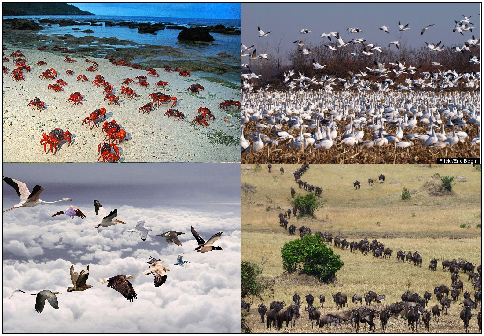
The migratory behavior of birds, fish, insects and even animals is fascinating to observe, both as a mystery of why it has evolved as well as the incredible endurance that many species exhibit during the movement, often over thousands of kilometers.
Mathematician Allison K Shaw of the University of Minnesota and naturalist Sandra A Binning of the University of Neuchâtel, Switzerland, describe in their paper in the journal, The American Naturalist, a mathematical analysis of the costs and a benefits of
animal migration, as against staying put. Apart from climate and habitat, which are the reasons to migrate that have been considered so far, Shaw and Binning consider the benefit escaping attack by parasites as being another major gain. Migration, however,
has its costs of risk and hardship, and they examine the conditions required for migration to still be viable as a method of escape from parasites. The study shows that apart from escape, including a degree of recovery from the effect of parasites that have
already had access brings the model closer to reality and allows partial migration to evolve.
Migratory movement, in this sense, is not just dispersal or spread of animals when their numbers increase, but a seasonal movement of a group of animals to a new habitat at a distance. Instances are of birds in the northern hemisphere that fly to the south
for the winter, antelopes and wildebeest in Africa that move 800 km seasonally for pasture or for calving, fish that move to spawning waters, often changing from salt water to fresh, or vice versa, sea birds that come ashore to breed, and so on.
Avoiding harsh weather, seeking food, safety during the breeding season, to help optimize the chances of survival in the face of changing environment, are good reasons for migration. An additional reason, although not equally well studied, Shaw and Binning
say in the paper, could be migration as a strategy to lower the risk and consequences of attack by infection or parasites. . Parasites are often adapted to existing conditions of salinity, humidity etc. and movement of the host to a different clime may make
it difficult for the parasites to survive. However, as all factors that promote migration are usually active at the same time, it is difficult, in practice, to isolate the separate reasons why migratory behavior has evolved. Theoretical studies, however, are
useful in considering how the influence of different factors may rise or fall in varying conditions, leading to insights into how migration may have evolved, the authors say.
Two mechanisms by which migration may deal with attack by parasites have been suggested, the paper explains. One is escape – by getting physically away from the environment that harbors the parasite. The other is migratory culling, where the act of migration
places stress on individuals infected by pathogens or parasites, so that many of the infected hosts do not survive. The current authors suggest a third mechanism, of recovery from parasite attack during migration. “Many migratory species move between different
habitat types or across strong environmental gradients (e.g., temperature, humidity, salinity, altitude, dissolved oxygen). Parasites are often picked up and lost at different rates in these habitats,” the authors say. Washing fish in water of different salinity
to get rid of parasites or skin infections is commonplace, and there are studies of the behaviour of some animals to seek warm climate or of birds to sun themselves to be free of parasites in their feathers. The same effect, of infection control, however,
has not been considered so far as an explicit reason for migration, the paper says.
Mathematical model
The paper creates a model of a population of individuals that live in a parasite infested environment, from which (some) a section of the individuals migrates for a period, while the remainder does not. While migration is arduous and takes its toll, the benefit
is that some of the infected ones that migrate would get rid of the parasites, while infected individuals that do not migrate would continue to be affected, and hence pay an infection-cost. And then, during the period of migration, some of the healthy ones
that (who) stayed back would get infected. Some of those that stayed behind would also die in the normal course and a so would a somewhat higher percentage of those that migrated, because of the stress of migration.
And finally, the migrants would return to the home habitat, which is the breeding ground. As the formula that has been developed gives a measure of how many healthy and infected individuals join in the breeding season, the model
is able to give the number of offspring born, and the newborns are taken to be without infection. The model also provides for a fecundity-cost, of the effect of infection on the ability of individuals to reproduce. The model hence works out the numbers of
healthy and infected individuals at the beginning of the second year, based on the numbers at the start of the first year. This, of course, is according to the assumptions of the proportion of the population that gets infected in a given time, the proportion
that migrates, as well as the rates taken for normal attrition, the infection cost, migration cost and the fecundity rates.

Given this picture of change over the year, the proportion that migrates, as assumed in the model, is moved up or down, till the numbers at the start of the second year come out the same as at the start of the first, which is to
say that there is equilibrium. This then provides a measure of how evolutionary forces should result in the proportion that actually migrates, for sustainability - the evolutionarily stable strategy.
The factors that were considered to affect the choices are (i) likelihood of infection in the home environment and of recovery during migration. (ii) likelihood of survival even when not infected, (iii) survivals costs, both of
infection and of migration and (iv) the effect of infection on reproductive ability. In the case where there are very high chances of infection as well as of recovery, the best strategy simply works out to comparison of the cost of migration and that of staying
put, and is a simple one or the other strategy. But in real life, Shaw and Binning analyse, even if there were a low chance of infection and the cost of migration were high, never to migrate would mean that an individual would have no way of recovery, once
she was infected, as sometime she must. The best strategy to evolve would hence be a mixed strategy, where a part of the population migrates and a part stays home, so that the chances of survival and hence the annual reproductive potential are optimised. This
is relevant, of course, the authors add, mostly when the lifetime of the organism is more than a few seasons, and mixed strategies are generally favoured when the chances of recovery are high and infection rate is low. With higher infection rates, migration
is generally the better choice. At the same time, they note, there are also counter-intuitive results when infection affects both survival as well as reproductive capacity. Migration may then become unlikely, as the organism may not live long enough for occasional
migration to help.
Researchers are increasingly recognising that parasite pressure can be a driver of large scale movement of animals, the authors say. While there are instances known of specific life cycle history in response to parasites, parasite
evasion has not been examined as the reason for the evolution of seasonal migration behaviour. On the other hand, researchers have paid more attention to the negatives of migration, like being susceptible to unknown pathogens, crowding at stopover points or
the weakened condition on arrival at the destination, the authors say. However, as migration is a fact, these negatives must be getting offset by the benefits, they say.

The scientists
Although there is little experimental data to support migratory recovery, there are instances of migrants benefiting by loss of parasites, and migratory recovery is a valid mechanism that explains evolution of partial migration, the authors say. The present
model that has been developed based on a long distance migration, but it could be modified to suit other conditions, they say. They invite other researchers to take into account the loss of parasites as a factor while studying animal movements and also to
improve the current model by refining the assumptions made.
[the writer can be contacted at response@simplescience.in]
|
Bird Watching
On the breeding of Purple Sunbird
By : Ajay Gadikar
Pleased to share with all readers a detailed observation on the breeding cycle of the purple sunbird (Cinnyris asiaticus) as seen from my balcony.
On 12th Feb 2015, I observed a female purple sunbird with some nesting material in her beak, immediately I understood that she must be constructing a nest in the vicinity. Within seconds, she perched on a twig and stated to tie down the two branches
of a climber tree. Looking from my window, I was overjoyed to see a sunbird nesting so close to my window. I decided to note down the daily routine of the sunbird in my diary and record observations thru a handy cam so that I can study the different aspects
of the breeding cycle of the purple sunbird. That day she brought more nesting material and started to prepare a nest.
I am sharing the whole observation in nutshell and will encourage all the bird watchers to document their bird sightings and observations in a notebook or on ebird website.
Male Sunbird sucking nectar from a flower
12th Feb (Day 1.) The first day of my observation. Twigs tied down and nesting material brought in very frequently.
13th Feb (Day 2.) The nest was now a long elongated structure. Saw her actually stitching the loose threads brought by her.
14th Feb (Day 3.) Further additions to the structure.
15th Feb (Day 4.) Now she started to give it a hollow pear shape, with an entry gate. A round circular entrance clearly visible.
16th Feb (Day 5.) She was going inside from the entry point and indulge more in preparing the inside structure. Unfortunately the nest opening was on opposite side when I looked from my window.
17th Feb (Day 6.) She was mostly bringing the cotton like soft material and putting it inside the nest.
18th Feb (Day 7.) Bringing more soft material and giving it the final shape.
19th Feb (Day 8.) Today she brought mostly soft material and put it inside the nest.
20th Feb (Day 9.) The nest has taken the complete shape. She took approximately 8 days to complete the nest.
21st Feb (Day 10.) Male was seen first time clinging to the nest and peeping inside.
22nd Feb to 24th Feb. (Day 11 to Day 13.) Out of station, so no observation.
25th Feb (Day 14.) Female was seen coming to the nest and sitting in the nest with her beak and face facing outwards. It means she must have laid the eggs. The Male remains near to the nest and also visited the nest, whenever he visits the nest he never
goes inside but did cling to the nest many times in the day to peep inside.
26th Feb (Day 15.) Today ashy prinia, tailor bird and red vented bulbul visited near the nest.
27th Feb (Day 16.) The female occupied the nest for longer periods 5 to 10 min. Examples of her timings of entering and leaving the nest were 07:39 – 07:44, 07:55 - 08:04.
28th Feb (Day 17) - The Male and female are foraging near the nest together. The female seems to remain inside the nest for a period of more than ten minutes. The male checks the nest from backside by peeping his beak through the structure.
1st march to 7th march (Day 18 to Day 24) - The female seems to be incubating the eggs, she now sits for quite long intervals inside the nest. The male also remains close by always.
8th of March (Day 25) - I carefully put a stair case and peep inside the nest and saw that it was 2 eggs of milky white colour lying deep inside.
9th March (Day 26) – Today she was seen feeding, although could not confirm as it was for very short durations.
10th March (Day 27) – Today it was clear that the female has actually ben feeding the chick. I got recordings of the full day.
Female sunbird feeding its chicks
11th March (Day 28) – The female was seen removing the remains of the egg from the nest in the morning. Now the feeding was very regular although with at least half an hour intervals. The female comes to the nest feeds some liquid (nectar) brought by
her then sits inside, seems to adjust inside.
12th March (Day 29) – Yesterday night it rained slightly with high wind speed with lot of thunderstorms, but was very pleased to see the nest intact. The male also come and feed the chicks.
Male sunbird feeding the chicks
13th March (Day 30) - It rained today as well, today the rain was more severe in the evening, the female is seen coming and feeding the chicks regularly in morning and afternoon and in the evening when the rain was heavy she was seen sitting inside the
nest.
A Shikra was calling from a tree nearby, when she was sitting inside the nest, she got very alert by the Shikra call.
14th March (Day 31) Again it rained in morning, she was seen inside the nest till 7:30 Am. As the rain ceases today she was seen near the nest but not feeding her chicks as usual, instead I watched her sitting beside her nest and checking the nest from
outside (left side) and also from upside from where the nest was tied on the twigs. I could not make out anything of this behaviour, then I left for the office, later my son who was at home told me in evening that she did come once or twice but did not feed
the chicks, I become worried and was thinking why it is so, as soon as I reached home at around 8:00 Pm, I checked the nest from below by a torch, I didn’t find the female inside the nest, a wrong signal, the fate of the family might have sealed by the rain,
still we all keep our hopes alive that tomorrow morning she will return to nest and feed the chicks.
15th March (Day 32) the usual chirping of the both male and female sunbird was heard, but they were not coming to the nest rather were occupied with their regular feeding activities. Today only once the male was seen visiting the nest temporarily and peeping
inside the nest, else they have not at all visited the nest. In the evening a climb thru a ladder up to the nest and tried to investigate the scenario, inside the delicate bodies of the sunbird babies were lying without any life in them, one was a little bigger
with his beak visible and second slightly smaller. It was very disheartening to see that, as I told my son and wife they also feel very bad about it.
The untimely and excessive rains has taken its toll on the sunbird family. This seems to be the primary reason for the death of the chicks.
The other two probable reasons of the death of the chicks could be the non-availability of food (nectar) for the chicks, as due to rains all the buds and flowers from the nearby flowing plants and trees had fallen down and the amount of food required could
not have been available for the chicks and secondly the cold weather that persisted for longer period than usual could be the other reason, as during march it hots up quite a lot which may provide the convenient temperature for providing the required warmth
to the babies.
A new Beginning
17th March. Today a new chapter has started. The female sunbird was seen picking up the nesting material from the old nest and taking it away, soon I found the location of the new nest site. She has started to build the new nest in nearby vicinity approx.
15 meters from her earlier nest. The same phenomenon of building the nest has started and my regular observation of her behaviour also started. I hope this time she should be able to rear up the chicks and complete the breeding process.
22nd March. Today the new nest has taken its shape, this one comes up faster than the earlier may be because most of the material was taken from the earlier nest side which saved her time and energy in search of the nesting material and she was able to
build the nest faster.
18th April 2015. The same cycle has been completed and this time the Male and Female purple sunbird has successfully fledged their chicks in the open sky..
Chicks waiting to be fed
During the study of this sunbird breeding I learnt a lot of behavioural aspects of sunbird.
Happy Birding.
Thanks.
Ajay Gadika
|
Events
Three day Workshops during 1st to 13th August at Kulgi Nature Camp in Kali Tiger Reserve, North Kanara District

Low cost bee- hives
Many farmers from the project area have adopted these methods and are able to successfully keep the elephants out of their crop fields. Although effective, the CBCM model is still in its infancy in India. In 2015 WRCS arranged a number of workshops for
training field staff and researchers in implementation of CBCM model, at Kulgi Nature Camp in Kali Tiger Reserve. These workshops were attended by 120 participants from various states such as Chhattisgarh, West Bengal, Nepal, Nagaland and Odisha.
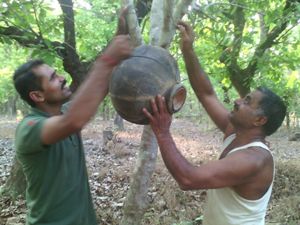
Low cost bee-hives in clay pots
Considering the response from the participants and the need to popularize the CBCM model, WRCS is organizing another workshop this year between 1st to 13th August at Kulgi Nature Camp in Kali Tiger Reserve, North Kanara District. The workshops will be
useful for Farmers, Community members, Forest Department Field Staff, Field Researchers, NGOs and students across the country dealing with Human-elephant conflict issues.

Chillie smoke drives away elephants
We request you to contact the coordinators at the earliest if you are interested in participating in the workshop. We also request you to circulate this email to suitable individuals and groups who may benefit from the workshop.
Prachi Mehta (prachimehta@wrcsindia.org) and Peeyush Sekhsaria (peeyush.sekhsaria@gmail.com)
Workshop Coordinators
|
Forest and trees
THE ARAVALLI CONUNDRUM
The shoe that fits one person pinches another-Carl Jung
-Usha Nair
There is sometimes a very fine line between what is right and what appears to be right. Policy makers are often placed in the unenviable position of having to decide between conflicting interests and lobbies where both sides have genuine arguments. Take
the case of environmentalists and developers-the former pleads the case for retaining and increasing the natural forests, flora and fauna; and the latter seeks to urbanize, industrialise, develop, so that people can have improved standards of living.
The current Aravalli imbroglio in India exemplifies the conflict between environmentalists and developers around the world. The ancient Aravalli Range extends for over 800 kms along Western India and is some 1500 million years old (compared to just 50
million for the Himalaya).According to Dr Rathore and Sukhadia, at the beginning of the 20th century, 80% of the total geographical area of the Great Aravalli mountain region was under natural vegetation cover. By 2001, the vegetative cover reduced to around
7%, due to the widespread felling of the trees, extensive mining, industrialisation, climatic changes and other direct or indirect factors,causing reduced rainfall, deforestation and denudation, increased soil erosion, drying up of water aquifers and lowering
of the water table. The Aravallis are today, an eco-fragile zone.
According to Greenpeace, the Aravallis are ecologically very significant, and form the catchments of rivers that originate from the hills and irrigate the plains of Northern India. They serve as an important groundwater recharge zone, providing sweet drinking
water to millions of people. The Aravallis also consist of unspoilt forests like the
Mangarbani which are home to nearly 300 native plant species, 120 bird species and many animals (jackal, neelgai, mongoose).The Ridge, which
is a northern extension of the Aravallis, are the green lungs for the city of Delhi and protects it from the hot winds of the deserts of Rajasthan to the west. It is also responsible for earning Delhi the tag of the world's second most bird-rich capital city,
after Kenya's Nairobi.[Wikipedia}.
The scrub forest is home to our National Bird
Recently, a study paper, placed on public domain, by the Institute of Forest Management, with the objective of bringing a minimum one-third of India’s geographical area under forest cover, has got environmentalists up in arms. While defining forests,
the paper excludes scrub forests, defined by the Forest Survey of India, as areas which have 0%-10% crown cover. An estimated 11500 hectares of the Aravallis, having scrub forests with less than 10% crown cover, which hitherto was declared a ‘No Construction
Zone’ through judicial intervention, may not get protection, if this paper serves as the basis of the future forest policy of India.
The resultant uproar is one of many around the world, and stems from the widely quoted/relied definition of forests, put forward by the United Nations’ FAO (Food and Agriculture Organisation)in 2010, as land spanning more than 0.5 hectares with trees higher
than 5 metres and a canopy cover of more than 10% or trees able to reach those thresholds in-situ. This definition is viewed as more official and international than the many other definitions of forest in different parts of the world, and is used by forest
departments of national governments and even by the UN Framework Convention on Climate Change. The importance of defining a forest is to ‘provide the conceptual, institutional, legal, and operational basis for the policies and monitoring systems that drive
or enable deforestation, forest degradation, reforestation, and forest restoration (van Noordwijk and Minang).
A forest guard on the look out for tigers in the scrub jungle of Sariska
The World Rainforest Movement alleges that FAO’s definition does not capture the complexity of forest ecosystems, but instead represents the paper and forest product industry lobbies by legitimising monoculture plantations. ’This greenwashing also opens
the doors of investors and governments to constant expansion projects’ and more subsidies and profits for the sector. The Movement pleads for a reconsideration of the definition by engaging in dialogue with local communities. Saski & Putz comment that there
are dangers where simple definitions are applied locally and there is need for a more nuanced and diversified approach to defining forest & reforest, to distinguish natural from planted forests, forests damaged by logging from second growth forests. In the
article ‘When is a forest, a forest?’ (2016), Chazdon observes that the definition of forest varies in tandem with management perspectives and objectives, e.g. value for timber or value for carbon storage, improving livelihoods of forest dependent people,
natural or planted forests, pre-existing or newly-established, continuous or fragmented, native or non-native species, etc. ‘Purpose-built and contextualized definitions are needed to support policies that successfully protect, sustain, and regrow forests
at national and global scales’.
It is evident that the definition of forest influences how we assess and interpret forest transition. If tree cover is the sole criteria, the change over time in the balance between ‘forest loss’ and ‘forest gain’ within a geographic region is extremely
difficult to measure and monitor. While ‘forest loss’ is concentrated and abrupt, easily documented through satellite imagery or aerial photos; ‘forest gain’ is a highly variable, dispersed and protracted process that is challenging to document and monitor.
There are those who question why the definition focuses exclusively on trees, and not on other living beings and organisms, such as plants, insects, mammals, reptiles, birds and even forest people. From the “land cover” perspective, forests are viewed as ecosystems
or vegetation types supporting unique assemblages of plants and animals. But from the “land use” perspective, forests are landholdings that are legally designated as forest, regardless of their current vegetation. No single operational forest definition can,
or should, embody all of these dimensions.
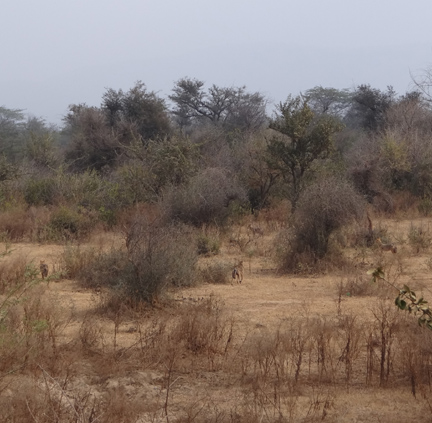 A pack of wild dogs hunting in the scrub forest
While global experts will take time to evolve a suitable definition of forests, national policy makers will have to grapple with the existing ambiguities; while the march of developers trampling on the environment will continue in the absence of unambiguous
norms that will clearly delineate forests. The Aravalli imbroglio is one of many such issues the world over, that falls between the letter and spirit of the definition of forest. Are we fighting a losing battle over forest conservation?
The photographs are by Susan Sharma, taken in the Sariska Tiger Reserve.
Usha Nair is a nature lover who can be contacted at ushaenvironment@gmail.com
|
Forest and trees
Is the Earth Still God’s Own Creation?
-Usha Nair
No Birds Sing in Monoculture “Forests”-Dalia Acosta
How many children today in urban cities are able to smell, let alone, appreciate the fragrance of flowers? Very few, because flowers are largely ‘engineered’-visually beautiful but emitting no fragrance. Similarly the children of tomorrow may not be able
to see the variety of flora and fauna that were sighted by their forefathers, because forests have also become ‘engineered’.
Primary forests are the original forests of native tree species, which covered the Earth, and are defined as virgin forests where there are no clearly visible indications of human activities and the ecological processes are not significantly disturbed.
Primary forests, according to Wikipedia, attain great age; they include diverse trees with multi-layered canopies, varying tree heights/diameters, various tree species/classes and woody debris. But today, a lot of wooded areas are categorised as forests and
are visually pretty, but do not have the features or benefits of the primary forests.
Primary forest created by Gurukul Botanical sanctuary, Wayanad, Kerala
Thus, Secondary forests regenerate on native forests, which have been cleared by natural or man-made causes. These forests display a major difference in forest structure and species composition and are generally unstable. Modified natural forests are forests
of naturally regenerated native tree species in places with indications of human activities. Semi-natural forests are forests of native tree species, established through planting, seeding or assisted natural regeneration. Forest plantations or monoculture
forests are forested areas artificially established by planting or seeding. The trees usually belong to the same specie (whether native or introduced), have the same age and are regularly spaced. The objective of forest plantations can be the production of
wood and non- wood goods (productive forest plantations) or the provision of ecosystem services (protective forest plantations). (Source: GreenFacts, based on FAO Forestry Department Terms and Definitions)
Primary forests (also called old growth /virgin/primeval forests) have been documented to host the greatest biodiversity, with the diverse ecosystems generally being more stable, productive and resistant to invasion and other disturbances. But flora and
fauna progressively declines in selectively logged forests, secondary forests and plantation forests. Hence, a transition from primary forest to degraded forest affects diversity without deforestation, while plantations will add to the stock of forests but
will host less biodiversity. It is now recognised that much of the human exploitation of forests has been at the expense of biodiversity impacting water, climate and carbon storage. Biodiversity is impacted by climate, and generally there is an increase in
species from the Poles to the Tropics. The tropical rainforests hosts at least two-thirds of the Earth’s terrestrial species. Old-growth forests also store large amounts of carbon, above and below the ground (either as humus, or in wet soils as peat). Destruction
of these primary forests releases this carbon as greenhouse gases, and may increase the risk of global climate change. Besides raw materials, old-growth forests provide ecosystem services that include breathable air, pure water, carbon storage, regeneration
of nutrients, and maintenance of soils, pest control by insectivorous bats and insects, micro- and macro-climate control, and the storage of a wide variety of genes.
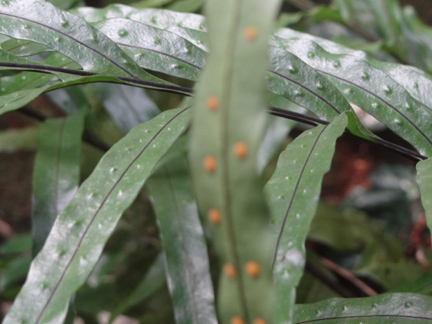 Spores from ferns in primary forests spread wide
Primary forests are rapidly vanishing. According to the World Resources Institute, as of January 2009, only 21% of the original old-growth forests that once existed on earth are remaining. The combined influence of high rates of deforestation, degradation,
over-harvesting, invasive species and global environmental change threatens to destroy tropical forests to extinction. Greenpeace reported that the continent-wise percentage distribution of the world's remaining intact forest landscape is 35% in Latin America,
28% in North America, 19% in Northern Asia, and 8% in Africa (which has lost most of its forest in the last 30 years) 7% in South Asia Pacific and 3% in Europe.
The original rationale and justification for clearing forestland was for food. Food continues to be a compelling reason for deforestation, as food demand is projected to double by 2050. Under current farming practices, this will require an additional 1
billion hectares (10 million sq. kms) of farming and grazing land— an area the size of Canada.
In recent decades, commercial considerations have overtaken basic needs.
Across continents, monoculture eucalyptus and pine plantations are advancing to supply paper pulp factories. Plantations of oil palm and artificial single-species forests, the so- called green deserts, are expanding fast across the Equatorial belt, fuelled
by low production costs and incentives from governments, causing severe social and environmental impacts. Guadalupe Rodríguez, a member of the Germany-based Rainforest Rescue, states that “monoculture forests tend to be seen as a good thing, because they are
green and pretty. But if you approach them, you won’t hear a single bird, because there is nothing there, just silence. A monoculture forest is almost like a stone quarry,” she added. “In tropical rainforests, by contrast, you hear animals, water flowing,
because they are full of life.” Brazil is a prime example - currently around seven million forested hectares in Brazil, mainly eucalyptus, are in plantations.
Further, forest crimes, the nexus of powerful lobbies and mafias, have become a harsh reality today. There have been instances where widespread forest fires have been suspected to have been started by timber mafias. Often companies planting artificial
forests, also kill off animals, like baboons, (approx. 3,000 baboons slaughtered in the last 10 years in South Africa), tigers and elephants (for smuggling of skins/ elephant tusks). In fact, illegal wildlife trade ranges from $7billion to $17 billion, while
illegal logging and trade in stolen timber range from $30 billion to $100billion annually. These forest crimes are growing and are amongst the top 5 types of transnational organised crimes.
Greenpeace rejects the industry’s claim that current practices are sustainable, and seeks restoration of natural site conditions and productivity, propagates mixed species plantation systems that work within the limits of natural soil and site conditions.
It envisages future market demands for ecologically sustainable wood products.
A Malabar pit viper in the GB sanctuary
As the 21st century grapples with the looming global challenge of climate change and its disastrous consequences, one wonders whether Thomas a Kempis’ 15th century quote of ‘Man Proposes, God Disposes’ needs to be corrected to ‘God Proposes and Man Disposes(Destroys)’.
The ecological equilibrium that Man was bestowed with, and the subsequent rampant, and often insensible, destruction of this unique balance of Nature has perched the globe and all of mankind on a precarious time bomb. It is evident that without clear policy
intervention and strengthening of national and regional forest governance, the remaining primary forests may disappear within the next few decades, to the detriment of all life on Earth.
------------------------------------
"There can be no rainforest beings - plants, animals and fungi - without an actual rainforest, be it large or small. Furthermore, there can be no sweet water, rain or cloud, without primary rainforest (primary habitat)."
-Quote from http://www.gbsanctuary.org
The photographs are by Susan Sharma
Usha Nair is a nature lover who can be contacted at ushaenvironment@gmail.com
|
News and Views
News..................
You must be noticing some changes on the appearance of http://indianwildlifeclub.com. We are finally a "responsive"
website in Google terms. That means the site will sense whether you are visiting from a smartphone or desktop and accordingly present the content to you.
Our free mobile app can be downloaded at
We hope this will soon become a documenting tool for those of you who travel and take photographs.
Keep yourself updated on media reports about Environment and wildlife by reading our Press section
Views.................................
Illegal wildlife and zero tolerance toward poaching was the theme for this year's World Environment Day. This unusual theme is indicative of a more holistic approach toward Planet Earth. Our short video to mark the occasion can be watched at
8th of June is celebrated as World Oceans Day. Not surprisingly, the theme is keeping the oceans healthy. Has it occured to us that every piece of plastic we throw away may be finally ending up in the ocean? The nature of plasic -its non biodegradable
nature-ensures that it stays on the earth long enough till the rains/rivers carry it to the oceans.
Watch the you tube video we have put together to mark the World oceans day
Please open a you tube account (if you have not already) and subscribe to our channel "Wildbytes TV"
|
Story Of The Month
Fish Culture in Paddy Field
-K. Amina Bibi
Karaikal is a small coastal enclave which was formerly part of French India. Together with the other former French territories of Pondicherry, Yanam, and Mahé, it forms the Union Territory of Puducherry. Karaikal is bounded on the North and South by Nagapattinam
district of Tamil Nadu state, on the west by Tiruvarur district (also belonging to Tamil Nadu), and on the East by the Bay of Bengal. The enclave is located 140 km south of the city of Pondicherry, 158 km east of Trichy and is known for its rich cultural heritage.
Forming part of the fertile Cauveri delta, the region is completely covered by the distributaries of Cauveri. Covered completely by a thick mantle of alluvium of variable thickness, the lie of the region is flat having a gentle slope towards the Bay of Bengal
in the east. (Source: Wikipedia)
Mr. Chandra Kumar, aged 38 is an engineer, resigned his highly paid job to do Organic Agriculture in Andoor Village of Karaikal District, Puducherry Union Territory. He wanted to take up SOMETHING DIFFERENT in Organic Farming.
A social media video on Fish Culture in Paddy field of Philippines made him sleepless and made him search more on this. After exploration on this he decided to venture his own model. He dug trench of two feet around his field and filled with canal water. He
introduced fish fingerlings from the canal; it was a mixture of traditional breed. Also he preferred to plant tradition paddy variety, Mappillai Samba, a red rice variety which can withstand standing water and do not demand chemical fertilizers. It responds
well to organic inputs and gives good yield.
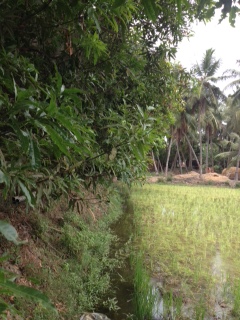
“Coastal saline soil extends from the main sea coast to a few or even 50 km at places interior to the main land. The ground water table under these soils is generally present at a shallow depth and contains high amount of soluble salts. These salts accumulate
on the surface of the soil due to capillary rise of saline groundwater during dry periods of the year rendering the soil highly saline. Almost the entire area of the rain fed coastal saline soil is mono cropped in nature. The major agricultural crop of kharif
is rice, grown during monsoon period when soil salinity is low. During the rest of the year, the land usually remains fallow due to high salt content of the soil.” This is how Tamil Nadu Agricultural University (TNAU), Coimbatore details about the coastal
ecosystem.
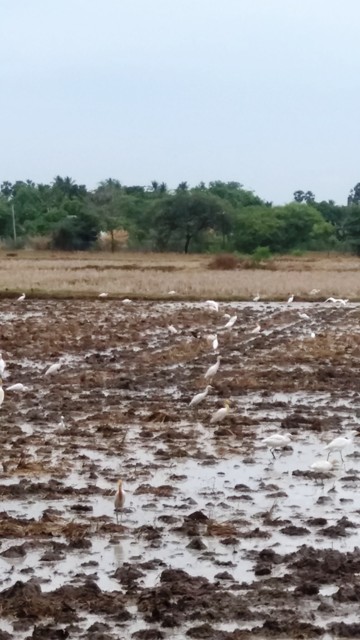
Chandra Kumar’s trenches have helped to leach out salts from the field and get accumulate in the trenches and the salt level is not harmful to fishes. Advantageously, the fish fed on the organic inputs like farm yard manures, vermicompost, green leaf manures
have turned the water into nutrient rich solution for the paddy to grow up on par with chemicals fed agriculture. The fishes grow into half to one kg in 150 days (duration of Mappillai Samba). He harvests the fish a week before paddy harvest and it is a bonus
of double income.
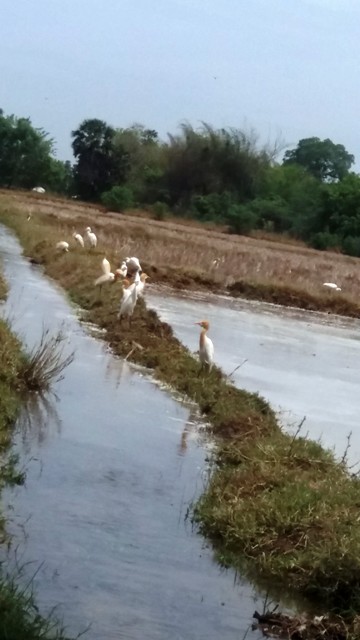
Fish culture along with Paddy gives an emotional satisfaction of producing food (paddy and fish) organically. Due to this reason both paddy and fish fetch better price than others in that area. Being fully Organic, the cost of inputs are drastically reduced
for the entire cropping season, except the trench making done at the time of land preparation. Economical utilization of land is done with which he gets dual income in an agricultural season. At the cost of sincere and personal attention every day as it is
an innovation and have no other bench marks to look upon.
K. Amina Bibi is Agriculture Officer, Karaikal. (Pondicherry) and can be contacted at bornagainamina@gmail.com, mobile 9443525661
|